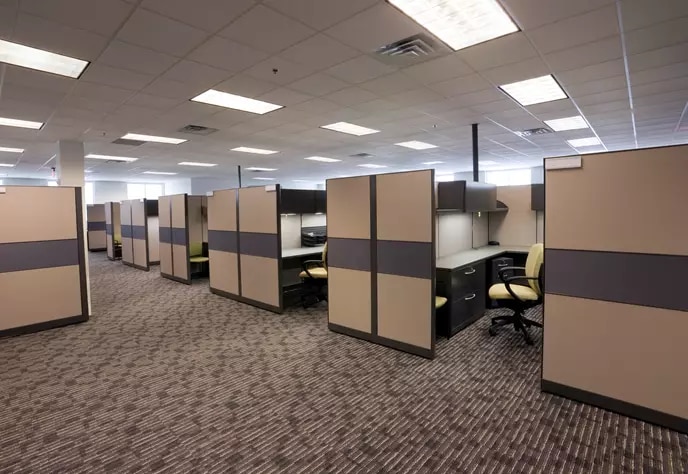
Walls or no walls? That's the question at the heart of the modern office design dilemma.
Over the last few decades, office spaces worldwide have embraced open spaces, adopting open office layouts and replacing the humble office cubicle.
As of 2023, 49% of UK employees were based in open plan offices, with UK companies favouring this office layout style over closed off spaces.
An open plan office layout is characterised by open space allowing employees to occupy the same floor space in a variety of seating arrangements, removing the physical and hierarchical barriers between workers.
In contrast, closed office spaces incorporate panels, cubicles and walls to create separate areas where workers are siloed away from each other.
But are open office spaces really worth the hype?
In this article, we will examine the pros and cons of open plan offices over closed layouts to determine once and for all which is superior in the contemporary working world.
The Pros of Open Plan Offices
Increased collaboration and communication
Open office layouts foster a culture of collaboration and communication.
Open layout design aims to encourage interaction which promotes collaboration and increases employee engagement and productivity. This not only enables teams to easily communicate but it also leads to the development of innovative solutions that drives business success.
With fewer physical barriers than office cubicles, an open environment allows employees to come together to interact more freely, share ideas, and work together to collectively problem-solve.
Boosts Employee Well being
An open office setup is linked with improved worker health and wellbeing, resulting in greater employee satisfaction and overall productivity.
Research shows that open plan layouts not only reduce social isolation, but it also builds a stronger sense of community and teamwork, directly counteracting stress and anxiety.
On top of this, the work environments created through open offices typically include wellness design features, such as biophilic and ergonomic furnishings.
Natural light-soaked spaces, ample ventilation, and tech-based temperature controls are all commonplace in open offices, all significantly benefiting the wellbeing of workers.
Greater flexibility
Open offices offer a wider variety of workspaces within the floor layout to suit the diverse needs of the workforce.
Whether these are dedicated quiet zones, collaboration areas and breakout pods, more workstation options can allow people to work in their most suited environment.
More flexible spaces can also benefit businesses that tend to have frequent cross-team collaboration, with workstations being easily modified for project requirements.
The Cons of Open Plan Offices
Distractions and noise levels
Open plan offices are dynamic and bustling office spaces, but with that leads to a higher rate of distractions.
More employees in one space means more office noise and more visual distractions that makes focused work difficult, decreasing productivity for many individuals who require quiet space to get stuff done.
Lack of privacy and personal space
With employees working side by side in a shared space, privacy and personal space is sacrificed in open plan offices.
The absence of physical barriers can make employees feel exposed and vulnerable, hindering focus and concentration.
This lack of privacy also makes sensitive conversations and confidential work a lot more challenging, such as one on ones or top-secret phone calls and meetings.
Difficulty maintaining concentration and focus
As touched on above, an open office plan makes it difficult many workers to complete individual tasks due to the lack of personal space and distractions.
Very few workers can properly focus with loud chit-chat, leading to lower productivity in many people.
The Pros of Cubicles
Greater privacy and personal space
Office cubicles provide a greater degree of privacy, allowing employees to concentrate on their tasks without the constant interruptions associated with open spaces.
This is particularly beneficial for workers who thrive in quiet areas. Imagine how much more you could get done if Steve and Debbie weren’t constantly talking opposite your desk.
Cubicles also offer a sense of personal territory, allowing employees to personalise their workspace and can have more control over their immediate surroundings.
Reduced distractions and noise levels
Walls, panels and cubicles, especially soundproof ones, minimises employee chit-chat and exposure to excessive noise through phone calls and impromptu meetings.
This ultimately creates a quiet workplace where individuals get more done, potentially impacting overall job satisfaction as well.
Increased ability to concentrate and focus
Private and closed office space creates a more focused atmosphere, enhancing productivity and concentration.
This enables workers to immerse themselves in their tasks, increasing individual problem solving and goal achieving.
The Cons of Cubicles
Encourages working in isolation
Closed office layouts hinder chance encounters and spontaneous conversations, making it difficult for employees to collaborate and form professional connections.
This is especially a downside for new employees, who are separated from teams and are limited to formal training for professional learning. This not only means that they can’t organically pick up on the intricacies of their job, it also makes socialising and team bonding harder for new hires.
As well as isolating teammates, cubicles and private offices also reinforces hierarchical structures, as higher ups tend to have the more spacious and better designed offices.
Less Spacious and Claustrophobic
Sure, a private or closed office is great for privacy and getting things done, but overtime these offices can feel claustrophobic and limiting, negatively impacting employee morale.
Rows of cubicles occupying almost all of the available space in the office means fewer recreational areas and meeting rooms as well, which isn’t great space utilisation for businesses either.
Lack of flexibility
Cubicle layouts are often rigid and difficult to adapt to changing workforce needs or team structures.
While employees have the option to change where they work in open plan space, this isn’t the case when there’s less space and fewer flexible breakout areas.
Looking to rent office space in London? Read about the Top 7 reasons why this is great for your business.
Types of open offices and closed offices
Open office spaces
Open office space falls into different categories, ranging from fully open offices or hybrid spaces that utilise a mix of open and private spaces.
Coworking spaces are flexible office spaces where individuals or teams from different organisations rent desks or offices on short-term leasing basis. Often embodying the open office concept, they prioritise community, collaboration, and cost-efficiency by providing shared amenities and networking opportunities.
In a coworking office, meeting rooms and private offices can be booked out in advance to overcome the challenges of open plan offices that we will discuss later.
Find a shared office space for your business
Closed offices
Unlike an open office set up, a closed layout comprises of cellular or cubicle offices that encloses individuals.
Individual offices offer privacy, security and independent working, making them fixed setups.
Private offices are the most popular type of closed offices and are usually used by executives and managers.
Finding the right office layout for your business
Both open-plan and cubicle offices present unique advantages and drawbacks.
While open spaces foster collaboration and creativity, they can also compromise privacy and focus.
Conversely, cubicles offer individual privacy and reduced distractions but may hinder communication and teamwork.
Ultimately, having access to both open and closed office spaces is ideal, balancing out these pros and cons.
Looking for office space that offers both closed and open space office design?
Servcorp provides thousands of businesses with flexible office space solutions and services, specialising in supporting your company’s success.
Get in touch with our friendly team to find your dream offices today.
Frequently Asked Questions






